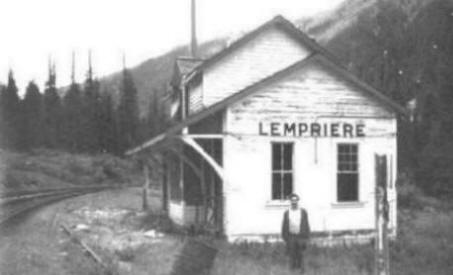On Canadian National Railway, NW of Penny
53.9167 N 121.4667 W — Map 093H14 — Google — GeoHack
Earliest known reference to this name is 1911 (GTP map)
Name officially adopted in 1983
Official in BC – Canada
Mile 79 in Fraser Subdivision (McBride to Prince George as of 1977)
Grand Trunk Pacific Railway station built in 1914. Removed 1963
Grand Trunk Pacific Railway map [ca. 1912]
Grand Trunk Pacific Railway timetable 1914
Pre-emptor’s map Fort George 1G 1916
Grand Trunk Pacific Railway map ca. 1918
Grand Trunk Pacific Railway map 1919
Canadian National Railway map 1925
Grand Trunk Pacific Railway stations
The name was submitted to the Geographical Board of Canada by Sir Alfred Smithers, chairman of the Grand Trunk Pacific Railway during construction of the rail link. The post office opened in October, 1915.
Longworth is located 80 miles west of McBride, it was quite possibly named after an English village in Oxfordshire, UK., (speculation on my part). It may have been one of the place names suggested by Josiah Wedgwood.
— Olson
Wrigley Directories for 1918 lists Longworth as a post office and station on the Grand Trunk Pacific Railway. Population 30. Local resources: Timber, prospecting, and a few small farms. There are no sawmills here and the district offers 25,000,000 feet which may be purchased cheaply from pre-emptors, while twice the amount is available on Government land adjacent to rail. Arthur E. Read was postmaster and ran the general store,and was also the first president of the Yellowhead Association around 1930.
The town of Longworth is on the map to stay. The place now boasts of a population of 100 residents, a good school, church, dance hall, store, post office and pool room. For awhile the settlement had a cabaret but it has been closed up and the piano taken away for repairs. In 1920 the post office was moved into the Toneko Lodge, a majestic wooden structure which also served as a hotel and general store.
— Prince George Citizen, February 28, 1924. Quoted by Olson
- Wrigley Directories, Limited. Wrigley’s British Columbia Directory. Vancouver: 1918. Internet Archive
- Olson, Raymond W. Ghost Towns on the East Line. Prince George, B.C.: Raymond W. Olson, 2017
- British Columbia Geographical Names. Longworth
